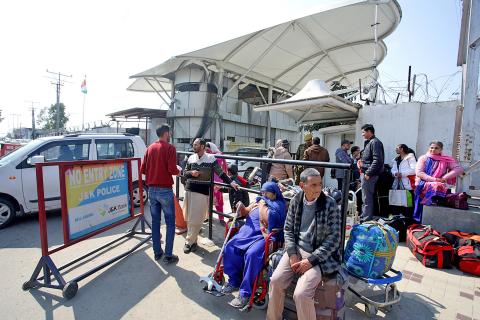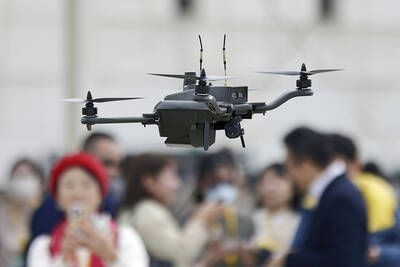Pakistan and India yesterday said that they had shot down each other’s warplanes in an escalating confrontation that has fueled concerns of a catastrophic conflict between the nuclear-armed rivals.
Pakistani Prime Minister Imran Khan called for talks between the neighbors, saying that “better sense should prevail.”
While both sides have sought to play down the threat of war, the rare air force engagement over the divided and disputed territory of Kashmir significantly raises the stakes in a standoff sparked by a suicide attack in the side controlled by India earlier this month.

Photo: EPA-EFE
Pakistan said it downed two Indian jets in its airspace and captured two pilots, while India confirmed the loss of one of its planes and said it had shot down a Pakistani fighter.
In a sign of the deepening crisis, Pakistan closed its airspace “until further notice.”
At least six airports were closed in India, and a vast area north of New Delhi was closed to civilian flights.
Pakistani military spokesman Major General Asif Ghafoor told a news conference that one of the downed Indian planes had fallen in Pakistani-held Kashmir, while the other came down on the Indian side of the heavily militarized Line of Control, the de facto border dividing the Himalayan territory.
“We do not want escalation, we do not want to go toward war,” Ghafoor said, adding that one of the captured pilots was in custody and the other was in the hospital.
The jets had been shot down after Pakistani warplanes earlier flew across the Line of Control to the Indian side in a show of strength, hitting non-military targets, including supply depots, he said.
Afterward, the two Indian warplanes crossed the Line of Control into Pakistani airspace, he added.
He denied initial reports that a Pakistani warplane had been shot down, calling accounts an F-16 had been lost incorrect, as none were used in the action.
Indian Ministry of External Affairs spokesman Rajeesh Kumar later announced that a Pakistani jet was hit as it took part in an operation “to target military installations on the Indian side.”
“In this engagement, we have unfortunately lost one MiG-21. The pilot is missing in action. Pakistan has claimed that he is in their custody,” he added.
The US and other members of the international community have acted to defuse tensions between the two previously.
“If I were Washington, I’d be in overdrive making telephone calls and signaling that it wants tensions to be de-escalated now,” said Moeed Yusuf, an expert at the US Institute of Peace in Washington. “The risks of letting this play out are too great.”

The combined effect of the monsoon, the outer rim of Typhoon Fengshen and a low-pressure system is expected to bring significant rainfall this week to various parts of the nation, the Central Weather Administration (CWA) said. The heaviest rain is expected to occur today and tomorrow, with torrential rain expected in Keelung’s north coast, Yilan and the mountainous regions of Taipei and New Taipei City, the CWA said. Rivers could rise rapidly, and residents should stay away from riverbanks and avoid going to the mountains or engaging in water activities, it said. Scattered showers are expected today in central and

COOPERATION: Taiwan is aligning closely with US strategic objectives on various matters, including China’s rare earths restrictions, the Ministry of Foreign Affairs said Taiwan could deal with China’s tightened export controls on rare earth metals by turning to “urban mining,” a researcher said yesterday. Rare earth metals, which are used in semiconductors and other electronic components, could be recovered from industrial or electronic waste to reduce reliance on imports, National Cheng Kung University Department of Resources Engineering professor Lee Cheng-han (李政翰) said. Despite their name, rare earth elements are not actually rare — their abundance in the Earth’s crust is relatively high, but they are dispersed, making extraction and refining energy-intensive and environmentally damaging, he said, adding that many countries have opted to

FORCED LABOR: A US court listed three Taiwanese and nine firms based in Taiwan in its indictment, with eight of the companies registered at the same address Nine companies registered in Taiwan, as well as three Taiwanese, on Tuesday were named by the US Department of the Treasury’s Office of Foreign Assets Control (OFAC) as Specially Designated Nationals (SDNs) as a result of a US federal court indictment. The indictment unsealed at the federal court in Brooklyn, New York, said that Chen Zhi (陳志), a dual Cambodian-British national, is being indicted for fraud conspiracy, money laundering and overseeing Prince Holding Group’s forced-labor scam camps in Cambodia. At its peak, the company allegedly made US$30 million per day, court documents showed. The US government has seized Chen’s noncustodial wallet, which contains

SUPPLY CHAIN: Taiwan’s advantages in the drone industry include rapid production capacity that is independent of Chinese-made parts, the economic ministry said The Executive Yuan yesterday approved plans to invest NT$44.2 billion (US$1.44 billion) into domestic production of uncrewed aerial vehicles over the next six years, bringing Taiwan’s output value to more than NT$40 billion by 2030 and making the nation Asia’s democratic hub for the drone supply chain. The proposed budget has NT$33.8 billion in new allocations and NT$10.43 billion in existing funds, the Ministry of Economic Affairs said. Under the new development program, the public sector would purchase nearly 100,000 drones, of which 50,898 would be for civil and government use, while 48,750 would be for national defense, it said. The Ministry of